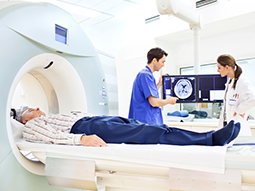What is interventional radiology in the liver?
When you’re suffering from liver disease, our interventional radiologists can give you the life-saving care you need with less pain and risk than traditional surgery.

Interventional radiology is a minimally invasive diagnosis and treatment option for patients suffering from illness or injury in their liver. From hardening of the liver, which causes life-threatening bleeding, to obstructed bile ducts and cancer, our interventional radiologists are experienced in treating a wide range of liver conditions, including but not limited to:
-
Bile duct obstruction
-
Cholecystitis
-
Portal hypertension
-
Metastatic liver cancer
When diagnosing and treating liver diseases, interventional radiologists use advanced imaging to guide a small needle or tube called a catheter. This allows them to effectively diagnose and deliver precise treatment for a variety of liver conditions.
Most interventional radiology procedures for liver diseases require only a small incision, the size of a pinhole, which reduces your pain and your risk for complication. Compared to traditional surgery, interventional radiology also allows for a quicker recovery, as most procedures can be completed in one day. Many patients are discharged the same day of their procedure, getting them back to the life and activities they love faster.
Interventional radiology in the liver treatments
Our interventional radiologists are skilled at performing life-saving procedures for patients suffering from cancer and other diseases affecting the liver.
Learn more about the interventional radiology treatment options for liver disease offered at MedStar Health below.
Balloon-occluded retrograde transvenous obliteration (BRTO)
Portal hypertension is when scar tissue blocks blood flow from the portal vein to the hepatic veins. This can lead to enlarged stomach and esophageal veins (called varices), which are at risk for bursting and creating dangerous internal bleeding.
Balloon-occluded retrograde transvenous obliteration (BRTO) is a minimally invasive procedure that can reduce the likelihood of rupture. It can be performed as a standalone treatment or as a supplement to a transjugular intrahepatic portosystemic shunt (TIPS) procedure.
Biliary drain placement
If your bile duct is blocked by scar tissue or a tumor, your interventional radiologist may use a minimally invasive procedure called biliary drain placement to drain the built-up bile in your liver. Since biliary drain placement only involves a small nick in the skin, you can also expect less pain and fewer risks of complication than open surgery.
Biliary stent placement
Similar to a biliary drain placement, biliary stent placement is used to drain built-up bile in the liver when the bile duct is blocked. Rather than using a catheter to drain the bile fluid outside of the body, biliary stent placement uses a plastic or metal tube to keep the bile duct open while the fluid drains internally.
Percutaneous transhepatic cholangiogram (PTC)
When the bile ducts are blocked, this can cause a buildup of bile in the liver, leading to further life-threatening health complications. Percutaneous transhepatic cholangiogram (PTC) is a diagnostic procedure in which X-ray images of the bile ducts are taken with contrast dye in order to help medical teams understand where exactly the blockage has occurred.
Transjugular intrahepatic portosystemic shunt (TIPS)
A transjugular intrahepatic portosystemic shunt (TIPS) is used to treat complications of portal hypertension, which occurs when scar tissue blocks blood flow from the portal vein to the hepatic veins. Our interventional radiologists are experts in using TIPS to reduce internal bleeding with fewer risks than open surgery.
Transjugular liver biopsy
A transjugular liver biopsy can help to diagnose or confirm a diagnosis of liver disease. As a minimally invasive procedure, your interventional radiologist will remove tissue samples from the body under the guidance of advanced imaging.
Unlike traditional biopsies, a transjugular liver biopsy is conducted through the jugular vein in the neck and into a hepatic vein. This makes it a safer approach for patients with a high risk for bleeding.
Our providers

Expert interventional radiology care
Getting the care you need starts with seeing one of our interventional radiologists.
Our locations
Distance from Change locationEnter your location
MedStar Good Samaritan Hospital
5601 Loch Raven Blvd. Baltimore, MD 21239
MedStar Franklin Square Medical Center
9000 Franklin Square Dr. Baltimore, MD 21237
MedStar Harbor Hospital
3001 S. Hanover St. Baltimore, MD 21225
MedStar Union Memorial Hospital
201 E. University Pkwy. Baltimore, MD 21218
MedStar Georgetown University Hospital
3800 Reservoir Rd. NW Washington, DC, 20007
MedStar Washington Hospital Center
110 Irving St. NW Washington, DC 20010
MedStar Southern Maryland Hospital Center
7503 Surratts Rd. Clinton, MD 20735
MedStar Montgomery Medical Center
18101 Prince Philip Dr. Olney, MD 20832
MedStar St Mary's Hospital
25500 Point Lookout Rd. Leonardtown, MD 20650









